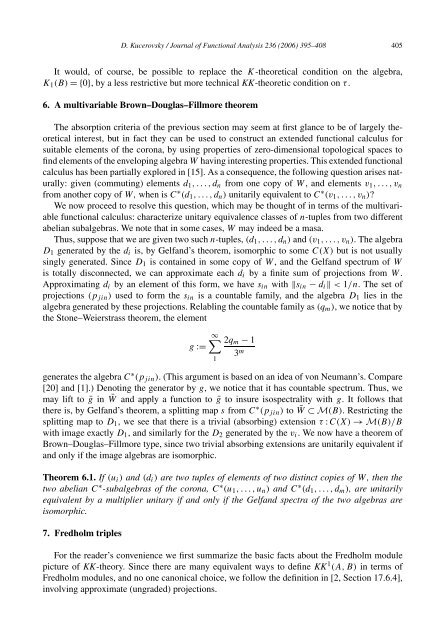Estimation optimale du gradient du semi-groupe de la chaleur sur le ...
Estimation optimale du gradient du semi-groupe de la chaleur sur le ...
Estimation optimale du gradient du semi-groupe de la chaleur sur le ...
Create successful ePaper yourself
Turn your PDF publications into a flip-book with our unique Google optimized e-Paper software.
D. Kucerovsky / Journal of Functional Analysis 236 (2006) 395–408 405<br />
It would, of course, be possib<strong>le</strong> to rep<strong>la</strong>ce the K-theoretical condition on the algebra,<br />
K1(B) ={0}, by a <strong>le</strong>ss restrictive but more technical KK-theoretic condition on τ .<br />
6. A multivariab<strong>le</strong> Brown–Doug<strong>la</strong>s–Fillmore theorem<br />
The absorption criteria of the previous section may seem at first g<strong>la</strong>nce to be of <strong>la</strong>rgely theoretical<br />
interest, but in fact they can be used to construct an exten<strong>de</strong>d functional calculus for<br />
suitab<strong>le</strong> e<strong>le</strong>ments of the corona, by using properties of zero-dimensional topological spaces to<br />
find e<strong>le</strong>ments of the enveloping algebra W having interesting properties. This exten<strong>de</strong>d functional<br />
calculus has been partially explored in [15]. As a consequence, the following question arises naturally:<br />
given (commuting) e<strong>le</strong>ments d1,...,dn from one copy of W , and e<strong>le</strong>ments v1,...,vn<br />
from another copy of W, when is C ∗ (d1,...,dn) unitarily equiva<strong>le</strong>nt to C ∗ (v1,...,vn)?<br />
We now proceed to resolve this question, which may be thought of in terms of the multivariab<strong>le</strong><br />
functional calculus: characterize unitary equiva<strong>le</strong>nce c<strong>la</strong>sses of n-tup<strong>le</strong>s from two different<br />
abelian subalgebras. We note that in some cases, W may in<strong>de</strong>ed be a masa.<br />
Thus, suppose that we are given two such n-tup<strong>le</strong>s, (d1,...,dn) and (v1,...,vn). The algebra<br />
D1 generated by the di is, by Gelfand’s theorem, isomorphic to some C(X) but is not usually<br />
singly generated. Since D1 is contained in some copy of W , and the Gelfand spectrum of W<br />
is totally disconnected, we can approximate each di by a finite sum of projections from W .<br />
Approximating di by an e<strong>le</strong>ment of this form, we have sin with sin − di < 1/n. Thesetof<br />
projections (pjin) used to form the sin is a countab<strong>le</strong> family, and the algebra D1 lies in the<br />
algebra generated by these projections. Re<strong>la</strong>bling the countab<strong>le</strong> family as (qm), we notice that by<br />
the Stone–Weierstrass theorem, the e<strong>le</strong>ment<br />
g :=<br />
∞<br />
1<br />
2qm − 1<br />
3 m<br />
generates the algebra C ∗ (pjin). (This argument is based on an i<strong>de</strong>a of von Neumann’s. Compare<br />
[20] and [1].) Denoting the generator by g, we notice that it has countab<strong>le</strong> spectrum. Thus, we<br />
may lift to ¯g in ¯W and apply a function to ¯g to in<strong>sur</strong>e isospectrality with g. It follows that<br />
there is, by Gelfand’s theorem, a splitting map s from C ∗ (pjin) to ¯W ⊂ M(B). Restricting the<br />
splitting map to D1, we see that there is a trivial (absorbing) extension τ : C(X) → M(B)/B<br />
with image exactly D1, and simi<strong>la</strong>rly for the D2 generated by the vi. We now have a theorem of<br />
Brown–Doug<strong>la</strong>s–Fillmore type, since two trivial absorbing extensions are unitarily equiva<strong>le</strong>nt if<br />
and only if the image algebras are isomorphic.<br />
Theorem 6.1. If (ui) and (di) are two tup<strong>le</strong>s of e<strong>le</strong>ments of two distinct copies of W , then the<br />
two abelian C ∗ -subalgebras of the corona, C ∗ (u1,...,un) and C ∗ (d1,...,dm), are unitarily<br />
equiva<strong>le</strong>nt by a multiplier unitary if and only if the Gelfand spectra of the two algebras are<br />
isomorphic.<br />
7. Fredholm trip<strong>le</strong>s<br />
For the rea<strong>de</strong>r’s convenience we first summarize the basic facts about the Fredholm mo<strong>du</strong><strong>le</strong><br />
picture of KK-theory. Since there are many equiva<strong>le</strong>nt ways to <strong>de</strong>fine KK 1 (A, B) in terms of<br />
Fredholm mo<strong>du</strong><strong>le</strong>s, and no one canonical choice, we follow the <strong>de</strong>finition in [2, Section 17.6.4],<br />
involving approximate (ungra<strong>de</strong>d) projections.

















